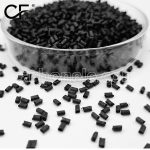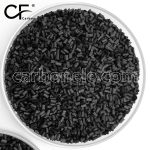
Carbon Fiber Reinforced POM CF20 Plastic Granules for Radiator Valves
POM CF20 has POM matrix and 20% carbon fiber. It offers high strength, rigidity, wear resistance, improved heat resistance, low thermal expansion, enhanced conductivity and good processing. Suitable for various parts and can be molded for complex shapes.
- Manufacturer: Carbon New Material
- OEM/ODM: Acceptable
- Color: Black
- Free Samples: ≤25kgs
- MOQ: 100kgs
- Port: Xiamen
- Model: POM-CF-BCA2
- Fillers: Carbon fibers
POM CF20 is an excellent engineering plastic composite. Here are some introductions:
Composition of POM CF20:
Matrix is POM, known for high mechanical strength, good wear resistance, excellent dimensional stability and chemical corrosion resistance. A widely used engineering plastic.
Contains 20% carbon fiber with high strength, high modulus and low density, enhancing material’s strength, rigidity and heat resistance.
Performance characteristics:
Mechanical:
High strength and rigidity. Addition of carbon fiber makes POM CF20 very strong and rigid. Tensile and bending strength greatly improved compared to pure POM. For high-load structural parts. In key mechanical parts, ensures stability in complex environments.
Good wear resistance. POM is wear-resistant. Carbon fiber further enhances this. Longer service life in friction. For gears, bearings.
Thermal:
Improved heat resistance. Carbon fiber raises heat resistance. Wider application range.
Low thermal expansion coefficient. Small dimensional change with temperature. Important for high-precision parts like in electronics.
Other:
Enhanced conductivity. Useful for electrostatic protection or conductivity needs.
Good processing. Can be molded by injection, extrusion. For complex shapes.
Preparation Procedures of POM CF20 Composites
1. Select suitable POM resin as matrix, 20% carbon fiber as reinforcement, and add additives as needed.
2. Put POM resin and carbon fiber in high-speed mixer for premixing. Adjust time and temp for uniform mixing.
3. Feed premix into twin-screw extruder. Set temp 160-200°C. Optimize screw speed and pressure. Cool and granulate.
4. Add composite particles to injection molding machine. Adjust parameters for good molding. Cool and demold.
It’s crucial to control process parameters. Post-treatments may enhance performance and life.
Main Application Fields of POM CF20
| Application Field | Application Scenario | Advantageous Characteristics |
|---|---|---|
| Automotive field | Automotive parts (gears, bearings, etc.), interior parts (center console brackets, etc.), engine peripheral parts (radiator valves, etc.) | High strength, high rigidity, good wear resistance, good dimensional stability, high temperature resistance, chemical corrosion resistance |
| Electronic and electrical field | Electronic equipment casings, electrical components (switches, sockets, etc.), wires and cables | Good insulation performance, high strength, conductive performance meeting electrostatic protection requirements, high rigidity, good wear resistance |
| Mechanical equipment field | Mechanical parts (gears, rollers, etc.), mold manufacturing (sliders, guide pillars, etc.) | High strength, high rigidity, good wear resistance, good processing performance, good dimensional stability |
| Aerospace field | Aircraft parts (seat frames, etc.), satellite parts | Low weight, high strength, good dimensional stability, fatigue resistance, good corrosion resistance |
| Other fields | Sports equipment (bicycle parts, golf club shafts, etc.), medical devices (surgical instrument handles, etc.) | High strength, lightweight, good biocompatibility, safe to use |
Notes:
1. Consider compatibility with other materials and avoid stress concentration caused by differences in thermal expansion.
2. Pay attention to weather resistance and can carry out surface treatment or add weathering agents.
3. Ensure compliance with safety standards such as flame retardancy and impact resistance, and conduct strict testing.
4. Control costs, optimize design and processes, and improve cost performance.
5. Pay attention to environmental protection performance and choose environmentally friendly materials and processes.
If you would like to learn further information on POM CF20 compounds or to understand more about other carbon fiber filled POM produced by Carbon New Material Company, please feel free to contact us.
How to Buy?
If you want to obtain information such as product specifications, performance, and price, choose a suitable product according to your own needs. Meanwhile, you can ask the manufacturer to provide samples for testing to ensure that the material meets your usage requirements. If you are interested in purchasing this composite material, please contact the manufacturer Carbon (Xiamen) New Material directly.

Frequently Asked Questions
Carbon (Xiamen) New Material Co., Ltd. aims to provide buyers with "one-stop" worry-free high-quality services. Here you can find all information about carbon fiber engineering plastics. If you still have questions, please send us an email for consultation!
-
How can I contact the manufacturer of a product that interests me?
When you find a product you are interested in, you can contact the manufacturer directly by sending an email and we will get back to you as soon as possible.
-
How do I find the products that interest me?
All you need to do is enter the keyword, product name in the search window and press the Enter key on your keyboard. Your search results page will then be displayed. You can also search within the product category pages on the home page. Each category is divided into subcategories, allowing you to refine your search and find products that interest you.
-
Where will I find a buying guide?
Please contact our after-sales service directly and we will provide you with a comprehensive operating guide.
-
What are CF Reinforced Thermoplastic Composites?
CF Reinforced Thermoplastic Composites are materials where carbon fibers are incorporated into a thermoplastic matrix. They combine the strength and stiffness of carbon fibers with the processability and recyclability of thermoplastics. For instance, they are used in automotive parts like bumper beams.
-
What are the benefits of CF Reinforced Thermoplastic Composites over traditional composites?
The key benefits include faster production cycles, easier recyclability, and better impact resistance. They also offer design flexibility. An example is in the manufacturing of consumer electronics casings where complex shapes can be achieved more easily.
-
How are CF Reinforced Thermoplastic Composites processed?
Common processing methods include injection molding, extrusion, and compression molding. Injection molding is widely used for mass production. For example, in the production of small components for the medical industry.
-
What industries use CF Reinforced Thermoplastic Composites?
They are utilized in aerospace, automotive, medical, and sports equipment industries. In aerospace, they can be found in interior components. In the medical field, they might be used in prosthetics.
-
How does the carbon fiber content affect the properties of the composites?
Higher carbon fiber content generally leads to increased strength and stiffness but may reduce ductility. A moderate content is often balanced for specific applications. For example, a higher content might be preferred in structural parts of a race car.
-
What are the challenges in using CF Reinforced Thermoplastic Composites?
Challenges include higher material costs, complex processing equipment requirements, and ensuring uniform fiber dispersion. Issues with adhesion between the fibers and the matrix can also arise. An example is in achieving consistent quality in large-scale production.
























